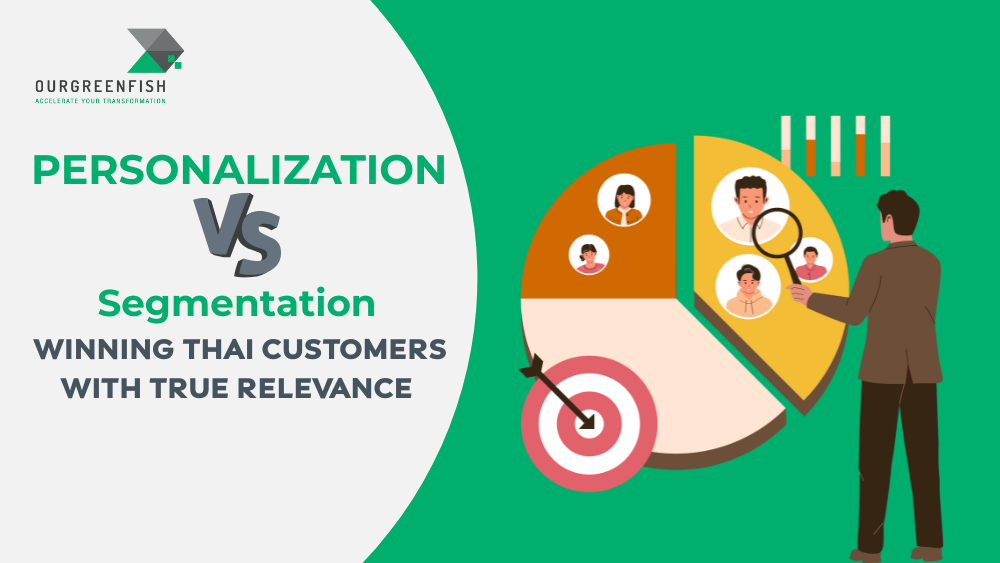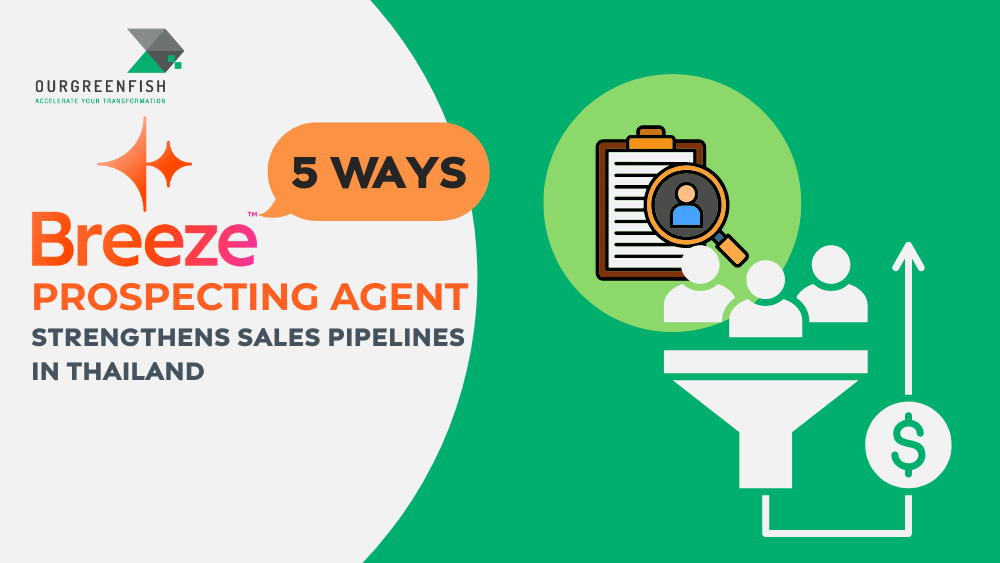Thailand’s digital landscape is vibrant and highly competitive. With 85% internet penetration and 65 million social media users (93% of the population), Thailand ranks among the world’s most active online societies. Thai consumers spend an average of 8 hours 49 minutes online per day, far above the global average. In such a crowded digital arena, generic one-size-fits-all marketing often falls flat. Brands need true relevance to cut through the noise. This is where personalization – as opposed to broad segmentation – becomes crucial for winning Thai customers. Personalizing marketing messages to fit local culture and individual preferences helps brands resonate with Thai consumers on a deeper level, leading to higher engagement and loyalty
Segmentation vs. Personalization: Understanding the Difference
Segmentation and personalization are related strategies but not interchangeable. Segmentation involves grouping customers into broad segments based on shared traits (e.g. demographics, location, behavior) and then targeting those groups with tailored messages. It makes marketing more relevant than mass marketing because people in a segment share similarities. However, segmentation does not equal personalization – it’s an early step, not the end goal. Even within the same segment, individuals can have very different interests and needs.
Personalization goes a step further by tailoring content to the individual, using granular data like browsing behavior, purchase history, and personal preferences. While marketers manually define segments, personalization is often powered by rules or AI that dynamically adjust messaging for each user. In short, segmentation is about understanding groups, whereas personalization is about engaging the individual. A broad segment might get a one-size-fits-all offer, but personalization delivers unique content or offers to each customer for maximum relevance.
Today’s consumers increasingly demand this level of relevance. In fact, globally 71% of consumers expect companies to deliver personalized interactions, and 76% report feeling frustrated when this doesn’t happen. The old approach of “blunt offers to large groups of people” is simply no longer effective in driving engagement. Nowhere is this truer than in Thailand’s fast-evolving digital market, where personalization is emerging as a key differentiator.
Why Personalization Resonates with Thai Consumers
Personalization (versus broad segmentation) especially resonates with Thai consumers due to cultural and behavioral factors. Thai people are deeply connected to their cultural identity and expect brands to speak their language – not just linguistically, but emotionally and culturally. A campaign crafted for a generic “Asia” segment or simply translated from English often misses the mark in Thailand. By contrast, a personalized approach that reflects Thai culture, values, and local trends makes consumers feel understood. Thai audiences respond strongly to marketing that weaves in storytelling, humor, and emotional appeal grounded in their cultural context. In other words, showing local flavor and personal relevance in messaging builds trust and affinity with Thai customers.
Broad segmentation might target Thai consumers as a single block or a few large groups, but it risks overlooking nuances that matter. For example, a broad segment could ignore regional language differences or cultural subtleties in Thailand’s diverse regions. True personalization accounts for these nuances – adjusting tone, slang, imagery, and references to align with what different Thai audiences find relatable. By tailoring messages to local festivals, social norms, or even internet memes popular in Thailand, marketers tap into what truly engages Thai consumers. Localized personal touches make an audience feel “this was made for me,” which dramatically increases engagement.
Crucially, Thai consumers have become very digitally savvy and socially engaged. They actively shape online trends instead of just following them, meaning they appreciate brands that keep up and personalize content in real-time to reflect what’s happening in their world. A generic segmented message sent to millions lacks this agility. In contrast, personalization lets brands deliver the right message at the right time – for example, sending a promotion with Thai New Year (Songkran) themes to relevant customers, or using a local pop culture reference in an ad for a younger Thai segment. These nuances resonate on a cultural level, fostering a sense of relevance and respect that Thai consumers reward with attention and loyalty.
Cultural Context Drives Higher Engagement in Thailand
There is tangible evidence that personalization and localization drive significantly higher engagement among Thai audiences than broad segmentation does. A striking example comes from a recent marketing localization case study in Thailand: A global brand’s campaign was initially just translated and broadly targeted, resulting in engagement rates 42% below the company’s benchmarks. The content failed to connect because it lacked cultural adaptation. After a comprehensive localization and personalization overhaul – rebuilding the message around Thai cultural values and preferences – the localized campaign saw engagement rates skyrocket by 215% (more than triple the original). Conversion rates jumped from a meager 0.8% to 3.5%, far exceeding targets. This dramatic improvement came from replacing a one-size-fits-all approach with culturally tailored content. It’s a clear win for true relevance: when Thai consumers saw messaging that reflected their humor, values, and context, they responded enthusiastically.
Other marketers have learned similar lessons. Simply translating slogans or ads from another market without personalization can backfire in Thailand. Global brands have faced backlashes for tone-deaf campaigns that ignored Thai cultural nuances. On the flip side, brands that localize visuals, language, and storytelling for Thailand see outsized success. For instance, KFC Thailand reimagined its global slogan with local Thai slang and humor, and introduced menu items suited to Thai tastes – resulting in hugely popular campaigns that felt “made just for Thai consumers”. The takeaway is that content tailored to Thai culture drives engagement far beyond what any broad regional segment approach could achieve.
Even on a tactical level, Thai consumer engagement metrics reinforce the value of localized personalization. Social media data shows that content aligned with Thai usage patterns performs better – e.g. videos under 15 seconds get 300% more engagement than longer videos in Thailand. Timing and channel matter too: posts made in Thai peak hours (such as 8-10 PM) see significantly higher interaction. A generic segmentation strategy might not account for these local behavior patterns, but a personalized data-driven strategy will adapt content format and timing to match Thai audience preferences. By respecting local context – whether cultural themes or digital habits – personalization boosts engagement metrics across the board.
Moreover, personalized marketing can directly improve conversion and ROI in Thailand. Tailored follow-ups and offers help recapture interested prospects who might have dropped off. Implementing retargeting and personalized messaging has been noted to lift conversion rates and ROI by re-engaging Thai consumers with content that speaks to their specific interests. In a nutshell, when Thai customers feel a message is truly relevant to them, they are far more likely to click, engage, and convert.
Personalization as a Competitive Edge in a Crowded Market
For businesses and investors looking at Thailand, personalization is not just a marketing tactic – it’s a strategic competitive edge. Thailand’s booming digital economy has attracted many players, making it a crowded market in sectors like e-commerce, fintech, and retail. Brands are all vying for the attention of tens of millions of online consumers. In this environment, delivering personalized experiences can set a company apart from competitors who rely on broad-brush segmentation. Brands that excel at personalization can capture more customer mindshare and foster loyalty, which in turn drives sustainable growth.
Critically, leading Thai brands are leveraging advanced personalization to stay ahead. By 2025, top marketers in Thailand are expected to extend personalization beyond basic product recommendations – incorporating customized content, timing, and even pricing for different customers. Those who integrate data across all touchpoints (social media, website, in-store, etc.) to build a 360° view of the customer will gain a significant competitive advantage. This means a retailer that knows a customer’s online browsing, store purchase history, and Line chat inquiries can personalize offers or messages far more effectively than one treating all “18-25 year old Bangkok females” as one segment. Investors should note that companies with such data-driven personalization capabilities can outmaneuver less adapted rivals in winning Thai customers.
From an ROI perspective, personalization in Thailand can be a game-changer. It leads to better allocation of marketing spend – resources aren’t wasted on broad campaigns to uninterested audiences, but rather focused on relevant communications to high-intent customers. This efficiency can improve margins and conversion rates. Globally, 65% of customers say targeted promotions are a top reason to make a purchase, and this mentality holds in Thailand where consumers are flooded with choices. A tailored promotion (for example, offering a discount on a product category you know the customer likes) can be the deciding factor that wins the sale. Companies that harness AI and analytics for personalization can run such targeted campaigns at scale, boosting growth and customer lifetime value.
Finally, personalization builds brand equity in a way segmentation alone cannot. Thai consumers often reward brands that show cultural respect and understanding – it humanizes the brand. In a market where trust and relationships are important, being locally relevant and customer-centric fosters goodwill. This intangible competitive edge can translate to stronger word-of-mouth and brand preference. For foreign investors evaluating the Thai market, a company’s personalization strategy can be a litmus test of how well it can adapt to local consumer behavior and outshine competitors. In summary, personalization is not only about immediate engagement metrics; it’s a long-term investment in relevance that fortifies a brand’s position in Thailand’s bustling marketplace.
Broad segmentation may have its place in planning, but winning Thai customers requires true personalization. Thai consumers are more engaged when marketing messages reflect their culture, language, and individual interests, rather than treating them as a faceless demographic group. Personalization – through localized content, data-driven recommendations, and real-time tailored offers – creates the kind of relevance that drives deeper connections and higher conversions. In Thailand’s crowded digital market, this level of relevance is a decisive competitive advantage for companies. Brands and investors aiming for success in Thailand should prioritize personalization strategies, knowing that speaking to Thai consumers on a personal and cultural level is the key to earning their business and loyalty
References :
- HubSpot. (2025). Meet Breeze — HubSpot’s AI tools that make impossible growth impossibly easy. Retrieved from https://www.hubspot.com/products/artificial-intelligence
- McKinsey & Company. (2025). Unlocking the next frontier of personalized marketing. Retrieved from https://www.mckinsey.com/capabilities/growth-marketing-and-sales/our-insights/unlocking-the-next-frontier-of-personalized-marketing
- Hashmeta. (2025). Localization Case Study: Global Campaign for Thai Audiences. Retrieved from https://hashmeta.com/blog/localization-case-study-thailand
- Hansem Global. (2025). Localizing Advertising Campaigns in Thailand. Retrieved from https://www.hansemglobal.com/localizing-advertising-campaigns-thailand
- TargetSeed. (2025). Conquering Thai Market Challenges: Solutions for Success. Retrieved from https://targetseed.com/blog/thai-market-challenges-solutions
- TechTarget. (2024). Personalization vs. segmentation: What’s the difference? Retrieved from https://www.techtarget.com/searchcustomerexperience/definition/personalization
Read more articles : Marketing to your target audience with Personalization Marketing (ทำการตลาดแบบรู้ใจกลุ่มเป้าหมายด้วย Personalization Marketing)
ติดต่อเรา
โทร: +66 2-0268918
อีเมล: contact@ourgreen.co.th
เว็บไซต์: ourgreenfish.com

.webp?width=158&height=85&name=New-logo-Ourgreen%20(1).webp)



















No Comments